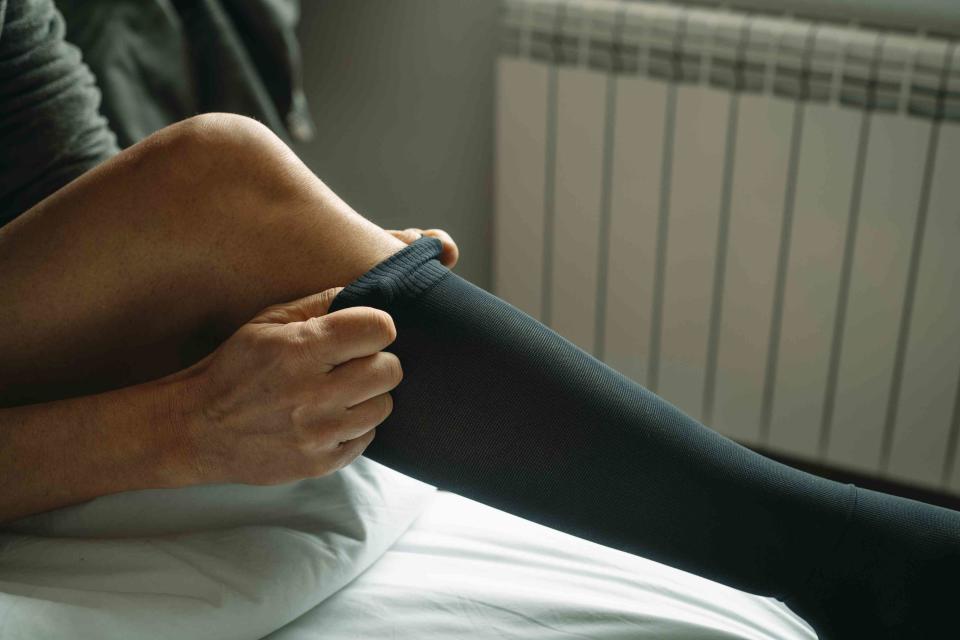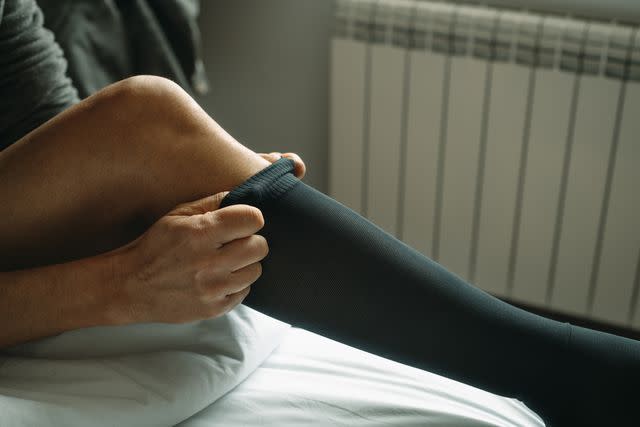What Do Compression Socks Do?
Here’s everything you need to know about compression socks

nito100 / Getty Images
Medically reviewed by Danielle McNeil, D.P.M
Compression socks—also known as compression stockings—are a garment that applies pressure to the ankles, lower legs, and feet. This type of legging comes in several different sizes and strengths and can serve a variety of medical purposes.
This article will detail how compression socks work, why people wear them, and which type might be right for your individual needs.

nito100 / Getty Images
What Are Compression Socks?
Compression socks are a pressure-inducing garment that usually cover a portion of the feet and lower legs. These snug stockings help improve venous circulation (blood traveling back to the heart). They also assist in reducing swelling by applying gentle pressure to the legs.
Many types of compression stockings are available over the counter and without a prescription. In some cases, however, your medical provider may recommend custom stockings. In these situations, the provider will typically take measurements of your legs to ensure the socks fit appropriately and provide the necessary pressure.
Types of Compression Socks
Finding the right type of compression sock can be confusing. This is because there are several different variables to consider, including:
Level of compression: The pressure level of a compression sock can be mild, moderate, or firm. This pressure is typically noted in millimeters of mercury (mmHg), with higher numbers equating to more compression. Your medical provider can advise you on which level is appropriate for your needs.
Length: Depending on the targeted region of the leg, compression socks can cut off at the ankle, knee, or even the thigh. The stockings can also have an open or closed toe to ensure the garment fits properly and has the intended effect. They also come in a pantyhose version.
Material: Several different elastic materials are used to manufacture compression stockings. These fabrics are designed to wick sweat from the covered region and make the garments more breathable. The socks also come in a variety of colors, making it easier to wear them with your normal attire.
Ensure a Proper Fit!
Make sure your compression socks are snug but not uncomfortably tight. Though you should feel the pressure applied, the stockings should not cut off your circulation or cause soreness.
Benefits of Compression Socks
Wearing compression socks can offer a variety of health benefits, including:
Diminished risk of blood clots: After an injury or surgery, the risk of a blood clot (also known as a deep vein thrombosis) increases because you are less active. Compression stockings lower this risk by improving blood flow in your legs while you are more sedentary. They are also recommended for people on long-haul flights, especially if they have risk factors for clotting.
Prevention of venous ulcers: The flow of blood through the veins in your legs often becomes less efficient as you age. This issue can cause lower leg sores, called venous ulcers, to develop. By improving the circulation in your legs, compression socks may help prevent this condition and the feelings of achiness or heaviness in the legs that can accompany it.
Decreased swelling: Compression socks support the lymphatic system by preventing fluid from accumulating in the lower extremities. By applying gentle pressure to the legs, these garments decrease the likelihood of swelling accumulating in this region of the body.
Improved pain levels: The enhanced circulation caused by wearing compression stockings can help alleviate arthritis-related pain and reduce local levels of inflammation.
Enhanced exercise recovery: Some studies show that wearing compression socks during exercise helps reduce fatigue and soreness in your muscles after your workout. These benefits are still under investigation and are not yet considered definitive.
How Do Compression Socks Work?
The heart pumps oxygen-rich blood to all parts of the body through the arteries. After providing nourishment to a given area, the blood pumps back to the heart through the body’s veins. Because the blood in the legs has to fight gravity and travel the farthest distance back to the heart, its flow occasionally becomes impaired.
Compression socks improve blood flow by squeezing the legs and helping the veins push the blood back to the heart. This pressure helps prevent blood from pooling in the lower extremities. The compression that these stockings provide also moves any swelling that is present through the body’s lymphatic system and out of the affected region.
Side Effects of Wearing Compression Stockings
Wearing compression stockings is reasonably safe. It is important, however, to consult with your medical provider and closely follow the wearing schedule they suggest. This is because wearing ill-fitting stockings for too long can lead to skin irritation and breakdown. Moisture buildup from perspiration may also cause localized infections to develop.
Learn More: We Tested 26 Pairs of Compression Socks. These Are the Most Comfortable and Effective
In very rare cases, pressure ulcers or even nerve injuries can also result from improperly fitting stockings. These situations are extremely uncommon and usually occur in individuals with poor sensation in their lower extremities.
Can Anyone Wear Compression Socks?
There are only a few groups of individuals who may be contraindicated from wearing compression socks. This includes people with:
Peripheral artery disease or skin grafting related to this condition.
Severely impaired sensation or peripheral neuropathy in the legs
Allergies to the compression stocking fabric
Severe swelling from congestive heart failure
A localized skin condition or infection
An anatomical deformity that would prevent the stocking from fitting properly
If you have questions about whether wearing compression stockings is appropriate for your condition, speak to a medical professional.
How Often Should You Wear Compression Socks?
Most people can wear compression socks on a daily basis. That said, the wearing schedule can vary greatly from person to person depending on the reason for wearing the stockings. Though some people wear compression socks only while exercising, others who are at risk of a blood clot may wear the stockings the entire time they are awake.
Learn More: Leg Swelling
Learn More: Leg Swelling
Taking your stockings off intermittently to prevent infections or skin irritation from occurring is important. Your healthcare provider is your best resource for determining a schedule that best fits your individual needs.
Summary
Compression socks are a medical garment that applies pressure to the legs, ankles, and feet. These stockings can serve a variety of purposes including preventing blood clots, improving circulation, and reducing swelling. Though wearing these socks is relatively safe, talking to your medical provider about what type of sock and pressure is right for you is important.

